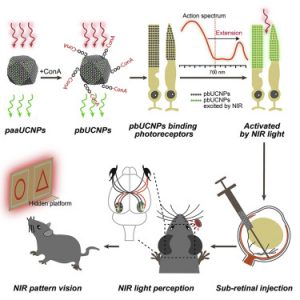Hollywood has long toyed with the idea of superhuman powers, as seen in the 2013 science fiction thriller movie Riddick, where the lead character uses his extraordinary night vision to survive a hostile world. It is one supernatural ability that may be closer to becoming a reality.
According to ScienceDaily, scientists have now made it possible for mice to pick up infrared light with the help of nanotechnology, creating the ability for night vision.
The procedure
It works with a single injection of photoreceptor-binding particles that is inserted into the mice’s eyes, converting photons to high-energy forms that allow the mice to develop infrared vision for up to 10 weeks. The procedure results in minimal side effects and causes no changes to normal vision.
How it works
Humans and other mammals eyes are naturally capable of picking up a range of wavelengths of light called visible light. Yet, infrared radiation, which has a longer wavelength, is all around us, although we’re unable to see it.
For mammals to absorb this longer wavelength, scientists at the University of Science and Technology of China and the University of Massachusetts Medical School developed nanoparticles that anchor tightly to photoreceptor cells and act as tiny infrared light transducers.
Testing
In order to assess whether mice could actually make sense of the infrared light, the researchers set up a series of maze tasks that showed the mice could indeed see infrared in daylight conditions, simultaneously with visible light.
“In our study, we have shown that both rods and cones bind these nanoparticles and were activated by the near-infrared light,” said senior author Tian Xue of the University of Science and Technology of China. “So we believe this technology will also work in human eyes, not only for generating supervision but also for therapeutic solutions in human red color vision deficits.”
What’s to come
It’s believed these findings could lead to advancements in human infrared vision technologies, including military operations.
“In the future, we think there may be room to improve the technology with a new version of organic-based nanoparticles, made of FDA-approved compounds, that appear to result in even brighter infrared vision,” said coauthor Gang Han of the University of Massachusetts Medical School.
ECS Digital Library
Want to learn more about nanotechnology? Stop by the ECS Digital Library for the latest research in the field!


